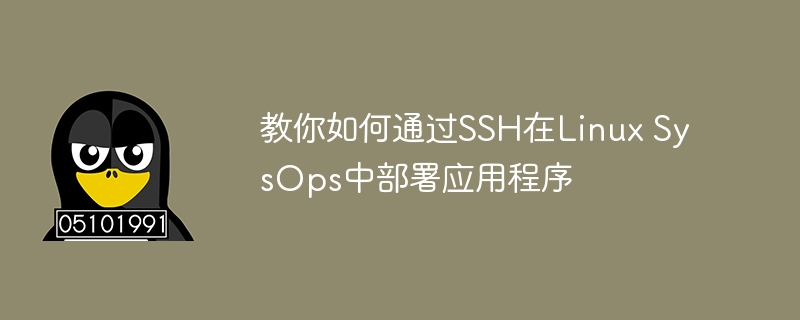Home > Article > Operation and Maintenance > Teach you how to deploy applications in Linux SysOps via SSH

Teach you how to deploy applications in Linux SysOps through SSH
Introduction:
In Linux system operation and maintenance (SysOps) work, deploying applications is An important task. Through SSH (Secure Shell), we can remotely log in to the Linux server and perform operations, including deploying applications. This article will teach you how to use SSH to deploy applications in Linux SysOps and provide specific code examples.
1. Preparation
Before you start, make sure you have the following conditions:
2. Connect to the server
Use an SSH client to connect to the server, open a terminal and enter the following command:
ssh username@server_ip_address
Where username is the username of your server, server_ip_address is the IP address of the server. Depending on the server configuration, you may also need to enter a password or SSH private key password.
3. Update the system and install dependencies
After the connection is successful, you first need to ensure that the server's operating system and software packages are up to date. Use the following command to update the system:
sudo apt update sudo apt upgrade -y
Depending on the Linux distribution you are using, you may need to use different package managers (such as yum, dnf, etc.) for the update operation.
Next, install the required dependencies according to the requirements of the application. An example command to install dependencies using the package manager is as follows:
sudo apt install -y dependency_package_name
You need to replace dependency_package_name with the real dependency package name according to the actual situation.
4. Deploy application code
Create a directory on the server to store application code and related files. For example, use the following command to create a directory named "myapp":
mkdir myapp cd myapp
To upload the application code from local to the server, you can use the scp command (Secure Copy):
scp -r /path/to/local/app_code username@server_ip_address:/path/to/remote/myapp
Where, /path/to/local/app_code is the path where the application code is stored locally, username is the server username, server_ip_address is the server IP address, and /path/to/remote/myapp is the directory path on the server where the application is stored.
5. Perform application installation and configuration
Go to the directory where the application code is located, and follow the installation instructions of the application to install and configure it. Normally, you need to execute a command similar to the following:
cd /path/to/remote/myapp ./configure make sudo make install
According to the actual situation, replace /path/to/remote/myapp with the real application code path.
6. Start the application service
After the installation and configuration are completed, use the following command to start the application service:
sudo systemctl start service_name
Among them, service_name is the service name of the application. Depending on the actual situation, you may need to use different commands (such as service or /etc/init.d) to start the service.
7. Test the application
After starting the service, you can use the following command to check whether the application is running normally:
sudo systemctl status service_name
If the service is running normally, relevant information will be displayed. If the service encounters an error or fails to start, you can view the log file for more information:
sudo tail -f /var/log/service_name.log
You can also visit the application's URL or use a telnet command (such as telnet localhost port) to test the application's response.
8. End the SSH session
When you have completed deployment and testing, use the following command to end the SSH session and exit the server:
exit
Conclusion:
Via SSH in Linux SysOps Deploying applications is an essential skill. This article provides a detailed guide to help you understand the process of SSH login, updating the system, installing dependencies, deploying application code, performing installation and configuration, starting services, and testing applications. I hope this article can be helpful to your application deployment in Linux SysOps work.
The above is the detailed content of Teach you how to deploy applications in Linux SysOps via SSH. For more information, please follow other related articles on the PHP Chinese website!